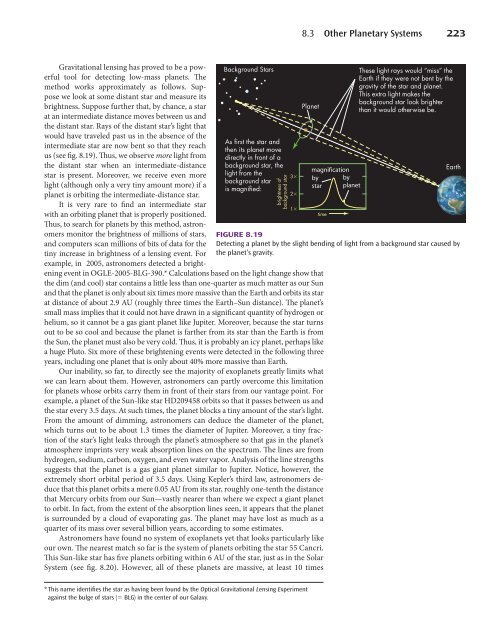Chapter 8
Chapter 8
Chapter 8
Create successful ePaper yourself
Turn your PDF publications into a flip-book with our unique Google optimized e-Paper software.
Gravitational lensing has proved to be a powerful<br />
tool for detecting low-mass planets. Th e<br />
method works approximately as follows. Suppose<br />
we look at some distant star and measure its<br />
brightness. Suppose further that, by chance, a star<br />
at an intermediate distance moves between us and<br />
the distant star. Rays of the distant star’s light that<br />
would have traveled past us in the absence of the<br />
intermediate star are now bent so that they reach<br />
us (see fi g. 8.19). Th us, we observe more light from<br />
the distant star when an intermediate-distance<br />
star is present. Moreover, we receive even more<br />
light (although only a very tiny amount more) if a<br />
planet is orbiting the intermediate-distance star.<br />
It is very rare to fi nd an intermediate star<br />
with an orbiting planet that is properly positioned.<br />
Th us, to search for planets by this method, astronomers<br />
monitor the brightness of millions of stars,<br />
and computers scan millions of bits of data for the<br />
tiny increase in brightness of a lensing event. For<br />
example, in 2005, astronomers detected a bright-<br />
Background Stars<br />
As first the star and<br />
then its planet move<br />
directly in front of a<br />
background star, the<br />
light from the<br />
background star<br />
is magnified:<br />
ening event in OGLE-2005-BLG-390.* Calculations based on the light change show that<br />
the dim (and cool) star contains a little less than one-quarter as much matter as our Sun<br />
and that the planet is only about six times more massive than the Earth and orbits its star<br />
at distance of about 2.9 AU (roughly three times the Earth–Sun distance). Th e planet’s<br />
small mass implies that it could not have drawn in a signifi cant quantity of hydrogen or<br />
helium, so it cannot be a gas giant planet like Jupiter. Moreover, because the star turns<br />
out to be so cool and because the planet is farther from its star than the Earth is from<br />
the Sun, the planet must also be very cold. Th us, it is probably an icy planet, perhaps like<br />
a huge Pluto. Six more of these brightening events were detected in the following three<br />
years, including one planet that is only about 40% more massive than Earth.<br />
Our inability, so far, to directly see the majority of exoplanets greatly limits what<br />
we can learn about them. However, astronomers can partly overcome this limitation<br />
for planets whose orbits carry them in front of their stars from our vantage point. For<br />
example, a planet of the Sun-like star HD209458 orbits so that it passes between us and<br />
the star every 3.5 days. At such times, the planet blocks a tiny amount of the star’s light.<br />
From the amount of dimming, astronomers can deduce the diameter of the planet,<br />
which turns out to be about 1.3 times the diameter of Jupiter. Moreover, a tiny fraction<br />
of the star’s light leaks through the planet’s atmosphere so that gas in the planet’s<br />
atmosphere imprints very weak absorption lines on the spectrum. Th e lines are from<br />
hydrogen, sodium, carbon, oxygen, and even water vapor. Analysis of the line strengths<br />
suggests that the planet is a gas giant planet similar to Jupiter. Notice, however, the<br />
extremely short orbital period of 3.5 days. Using Kepler’s third law, astronomers deduce<br />
that this planet orbits a mere 0.05 AU from its star, roughly one-tenth the distance<br />
that Mercury orbits from our Sun—vastly nearer than where we expect a giant planet<br />
to orbit. In fact, from the extent of the absorption lines seen, it appears that the planet<br />
is surrounded by a cloud of evaporating gas. Th e planet may have lost as much as a<br />
quarter of its mass over several billion years, according to some estimates.<br />
Astronomers have found no system of exoplanets yet that looks particularly like<br />
our own. Th e nearest match so far is the system of planets orbiting the star 55 Cancri.<br />
Th is Sun-like star has fi ve planets orbiting within 6 AU of the star, just as in the Solar<br />
System (see fi g. 8.20). However, all of these planets are massive, at least 10 times<br />
* This name identifi es the star as having been found by the Optical Gravitational Lensing Experiment<br />
against the bulge of stars (= BLG) in the center of our Galaxy.<br />
brightness of<br />
background star<br />
M B<br />
3�<br />
2�<br />
1�<br />
8.3 Other Planetary Systems 223<br />
Planet<br />
magnification<br />
time<br />
These light rays would “miss” the<br />
Earth if they were not bent by the<br />
gravity of the star and planet.<br />
This extra light makes the<br />
background star look brighter<br />
than it would otherwise be.<br />
8 km/sec<br />
FIGURE 8.19<br />
Detecting a planet by the slight bending of light from a background star caused by<br />
the planet’s gravity.<br />
arn12176_ch08.indd 223 7/30/09 2:14:47 PM<br />
by<br />
star<br />
by<br />
planet<br />
M A<br />
Earth

















